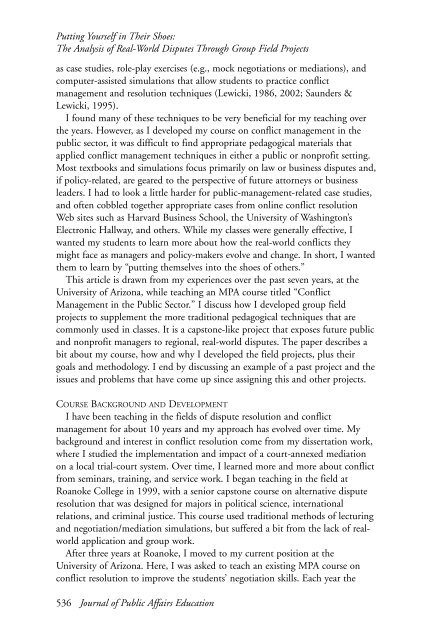JOURNAL OF PUBLIC AFFAIRS EDUCATION - National ...
JOURNAL OF PUBLIC AFFAIRS EDUCATION - National ...
JOURNAL OF PUBLIC AFFAIRS EDUCATION - National ...
Create successful ePaper yourself
Turn your PDF publications into a flip-book with our unique Google optimized e-Paper software.
Putting Yourself in Their Shoes:<br />
The Analysis of Real-World Disputes Through Group Field Projects<br />
as case studies, role-play exercises (e.g., mock negotiations or mediations), and<br />
computer-assisted simulations that allow students to practice conflict<br />
management and resolution techniques (Lewicki, 1986, 2002; Saunders &<br />
Lewicki, 1995).<br />
I found many of these techniques to be very beneficial for my teaching over<br />
the years. However, as I developed my course on conflict management in the<br />
public sector, it was difficult to find appropriate pedagogical materials that<br />
applied conflict management techniques in either a public or nonprofit setting.<br />
Most textbooks and simulations focus primarily on law or business disputes and,<br />
if policy-related, are geared to the perspective of future attorneys or business<br />
leaders. I had to look a little harder for public-management-related case studies,<br />
and often cobbled together appropriate cases from online conflict resolution<br />
Web sites such as Harvard Business School, the University of Washington’s<br />
Electronic Hallway, and others. While my classes were generally effective, I<br />
wanted my students to learn more about how the real-world conflicts they<br />
might face as managers and policy-makers evolve and change. In short, I wanted<br />
them to learn by “putting themselves into the shoes of others.”<br />
This article is drawn from my experiences over the past seven years, at the<br />
University of Arizona, while teaching an MPA course titled “Conflict<br />
Management in the Public Sector.” I discuss how I developed group field<br />
projects to supplement the more traditional pedagogical techniques that are<br />
commonly used in classes. It is a capstone-like project that exposes future public<br />
and nonprofit managers to regional, real-world disputes. The paper describes a<br />
bit about my course, how and why I developed the field projects, plus their<br />
goals and methodology. I end by discussing an example of a past project and the<br />
issues and problems that have come up since assigning this and other projects.<br />
COURSE BACKGROUND AND DEVELOPMENT<br />
I have been teaching in the fields of dispute resolution and conflict<br />
management for about 10 years and my approach has evolved over time. My<br />
background and interest in conflict resolution come from my dissertation work,<br />
where I studied the implementation and impact of a court-annexed mediation<br />
on a local trial-court system. Over time, I learned more and more about conflict<br />
from seminars, training, and service work. I began teaching in the field at<br />
Roanoke College in 1999, with a senior capstone course on alternative dispute<br />
resolution that was designed for majors in political science, international<br />
relations, and criminal justice. This course used traditional methods of lecturing<br />
and negotiation/mediation simulations, but suffered a bit from the lack of realworld<br />
application and group work.<br />
After three years at Roanoke, I moved to my current position at the<br />
University of Arizona. Here, I was asked to teach an existing MPA course on<br />
conflict resolution to improve the students’ negotiation skills. Each year the<br />
536 Journal of Public Affairs Education

















